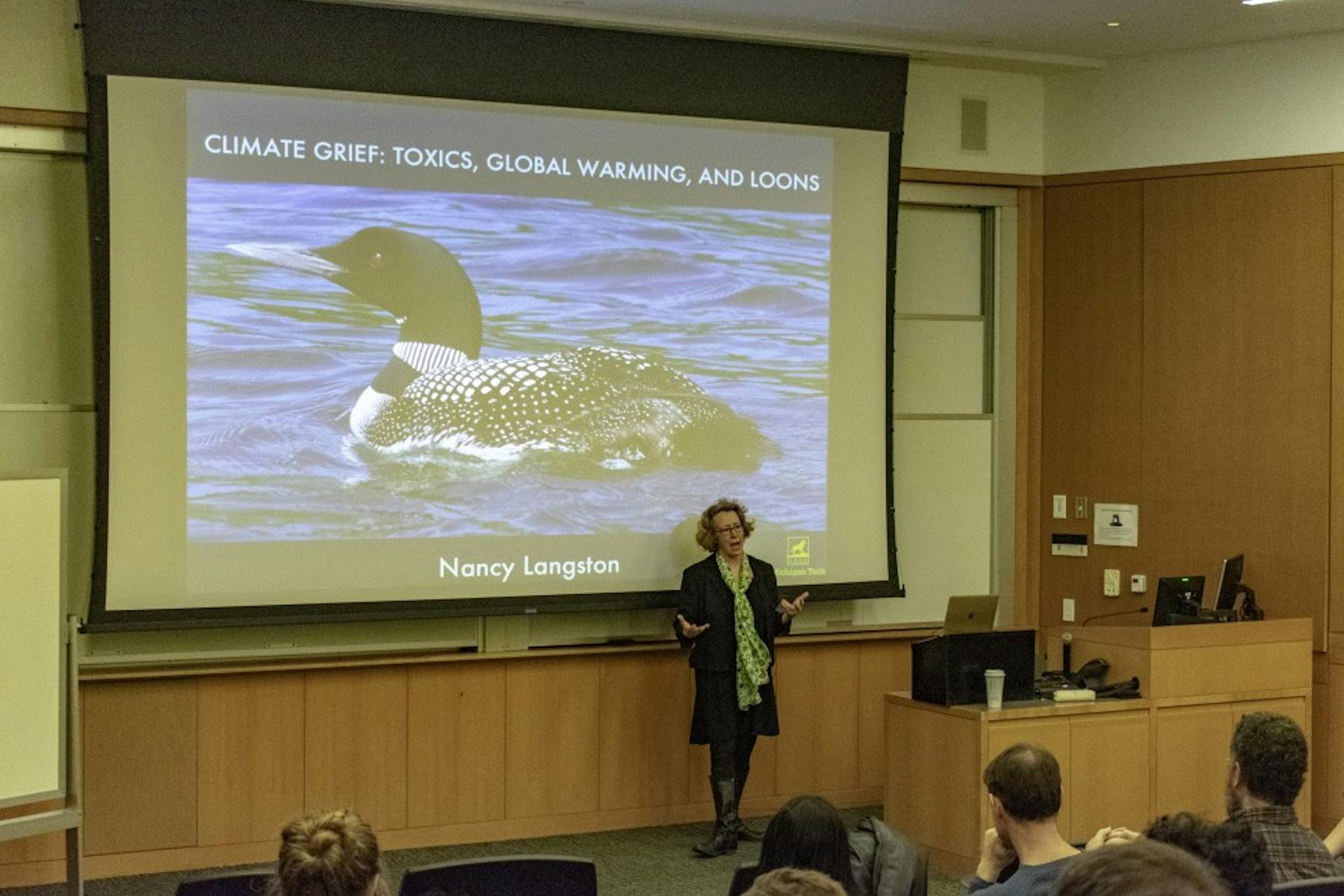Expert explains impact of human activity and pollution on loons
Environmental historian and author Nancy Langston spoke about the effects of human life on the habitat and well-being of the common loon as part of Brandeis’ annual Mandel Lectures in the Humanities on Thursday. Her presentation, “Climate Grief: Toxics, Global Warming and Loons,” explained the threats to loons as well as their cultural significance.
The Mandel Lectures in the Humanities started in 2011 to push for the study of humanities at Brandeis, after the Mandel Center opened in 2010. Each year’s lectures are turned into a book at the end of the series.
Langston, currently a professor of environmental history at Michigan Technological University, explained that the loons’ dense bones and the positioning of their feet allow them to swim very quickly and as deep as 250 feet under the water. In the summer, loons make their homes at ponds and lakes in the northern United States and Canada, and they migrate to the Atlantic and Gulf coasts in the winter.
According to Langston, loons are “indicators of watershed health” and “give us a wake-up call to see what we could not see otherwise.” A thriving loon population would signal a robust ecosystem, but the loon population is currently decreasing across the United States and Canada. According to the National Audubon Society, the common loon population has been steadily declining over the past 20 years, and is “endangered in Vermont, threatened in New Hampshire and Michigan, and a species of special concern in New York, Connecticut, and Massachusetts.”
Langston described how human activities have diminished the loon population in North America. She explained that the rise of tourism in the northern United States that started in the 1930s disturbed the loons’ habitats, especially with the spraying of the insecticide DDT, which, according to Langston, was used in this region primarily to curb the mosquito population.
DDT is an insecticide that is toxic to wildlife and harmful to humans. It was used largely for pest control in the agricultural sector and by the military to control malaria and other diseases. The Environmental Protection Agency banned the use of the insecticide in the United States in 1972.
Because loons migrate from the northern United States to the ocean, Langston explained, habitat destruction in the north in conjunction with environmental threats near the coast — such as the 2010 Deepwater Horizon oil spill — has destroyed many of the birds’ potential homes.
In addition to their shrinking habitats, loons face a number of other threats, including lead poisoning, Langston said. She explained that the ingestion of lead weights used on fishing lines are a major cause of death for loons in many northern states. In New Hampshire, for example, 49 percent of loon deaths between 1998 and 2012 were caused by lead poisoning, according to a 2017 Washington Post article.
Mercury pollution is another threat to loons, Langston said. She explained how mercury accumulates through the food chain and becomes very concentrated in loons. First, algae and phytoplankton absorb small deposits of mercury from the water. Zooplankton and insects eat the algae, small fish eat the zooplankton and insects, and so on in the food chain until the mercury reaches the loons, when it is 10 million times more concentrated than it was in the water, according to a diagram in Langston’s presentation.
The loons then pass this mercury poisoning down to their offspring. The presence of the mercury changes the loons’ behavior, Langston said. While loons usually carry their young offspring on their backs to conserve heat and keep them safe from predators, loons with mercury poisoning refrain from carrying their chicks on their backs. Loons with high levels of mercury in their blood spend less time sitting on their eggs, feed their offspring less frequently and in general do not have the energy to properly care for their chicks. As a result, it is becoming increasingly common for young loons to die before reaching adulthood.
When lakes and ponds are more acidic from acid rain, Langston said, it speeds up a chemical process, called methylation, that makes mercury more toxic. Acid rain is also toxic to fish, leaving less food for the loons. Loons are also killed by botulism, a type of bacteria poisoning. According to a 2014 study by the Biodiversity Research Institute, over 10,000 waterbirds on Lake Michigan, mostly common loons, were killed as a result of type E. botulism during the 2006 and 2007 fall migration periods.
Langston emphasized that the environmental effects of human activity pose continuous problems for the loon population, saying, “They are profoundly entangled in our fossil fuel-extracting economies … [so] no place is remote or distant any longer.” She pointed out that even humans who are nowhere near the loons’ habitat are a threat because they contribute to climate change. “These changing climates are creating these intensifying stressors that remobilize contaminants, that really affect the migration of these creatures,” she said.
Not only are loons indicators of a healthy ecosystem, Langston said, but they also have cultural significance to many different nations. In Ojibwe culture, she said, the loon is symbolic of creation. In an Inuit folktale, a loon helps restore a blind boy’s vision. Canadian Cree folklore says that the loon’s birdcall represents the cries of those who died in battle. “Loons are part of our iconography, they’re part of our cultural histories and identities,” Langston said.
Langston gave three other talks as part of this year’s Mandel Lectures: “Ghost Species: The Uncertain Future of Woodland Caribou in the Anthropocene” on March 11, “Environmental Humanities and the New Mobilities of the Anthropocene: Climate Change and Animal Migrations in the North” on March 13 and “Welcoming Back Namao: Indigenous Communities and Restoration of the Great Lakes Sturgeon” on March 13.




Please note All comments are eligible for publication in The Justice.